Contents
Collibia wood-loving refers to conditionally edible mushrooms, which must be boiled before use. Mushroom pickers willingly eat wood-loving collibia, despite the absence of a pronounced taste. It grows from spring to late autumn, it is often confused with meadow mushrooms and poisonous twin mushrooms.
Description of the forest-loving Collibia
The forest-loving collibium (from lat. Collybia dryophila) has recently been reclassified from the collibium genus and the ordinary family (Tricholomataceae) into the genus Gymnopus (Gymnopus) and the family of the non-mushrooms (Marasmiaceae). It also has other names:
- oaky or oaky;
- ordinary money;
- spring honeydew.
Cap Description
According to the description of the spring mushroom, it is characterized by a convex hat, resembling a sphere, which, as it grows older, becomes flat and prostrate, with a convex or slightly depressed center. The cap is smooth to the touch, its diameter varies between 2-8 cm.
At first glance, not all mushroom pickers manage to recognize the forest-loving collibia, because. colors change with the environment. The color of the cap may be reddish-red, especially in the center. Then the color fades, becoming pale beige, with translucent wavy or lowered edges through which the plates are visible. With age, dark reddish stains or spots remain, and the edges are torn.
The plates are paler than the cap, without a red-orange tint, adhere to the stem. Spores are white. The pulp is thin, whitish; the smell is weak, the taste is difficult to discern. It is used for cooking.
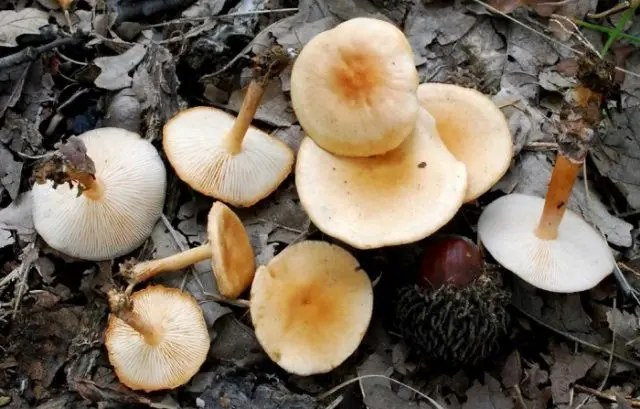
Description of the leg
The leg is not eaten because of its fibrousness and rigidity. It is thin, smooth, empty inside, from 2 to 7 cm long, 2-4 mm in diameter, slightly thickened downwards. The photo of the forest-loving collibium shows that the color of the legs is the same or slightly lighter than that of the cap, sometimes brown-red at the base.
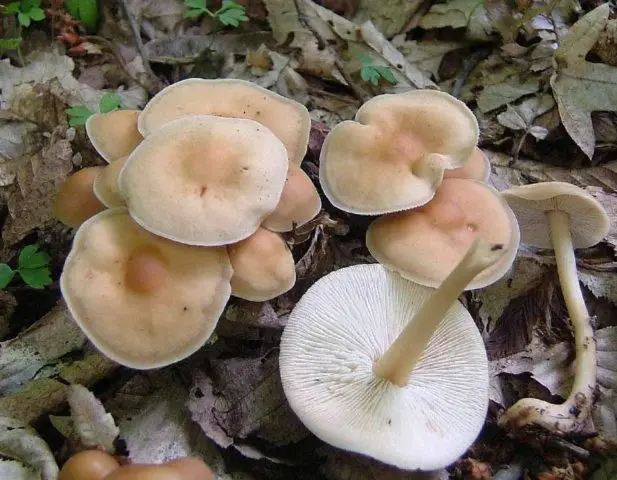
Is the forest-loving Collibia edible or not
The forest-loving collibia is conditionally edible, only the tops are eaten, but they are rarely used in cooking, because a large amount of product will be needed for harvesting, and not everyone will be pleased with the taste of the spring honey agaric. If wood-loving collibium is not properly processed, a person who does not suffer from a digestive system disorder may experience pain in the stomach or intestines.
The aroma of the mushroom dish is also repulsive, to many it resembles the smell of mold or rot. However, adherents of a healthy lifestyle collect and eat wood-loving collibia, as scientists have proven that it contains a large number of active elements that are beneficial to health. They increase the body’s immunity and resistance to infections, favor the work of the heart and strengthen blood vessels, are a natural antioxidant, immunostimulant and antiviral agent. The wood-loving collibium contains a lot of proteins, carbohydrates and fiber, as well as vitamins (B1 and C), zinc, copper and minerals.
How to cook forest-loving Collibia
Before cooking dishes from wood-loving collibia, it is boiled for at least 30 minutes. At the first boil, the water is drained, new water is added and cooking continues.
After heat treatment, mushrooms can be stewed or fried, eaten with cereals or vegetable and meat dishes, as well as separately. You can freeze, dry or pickle wood-loving collibia. It is added to the soup 20 minutes before it is ready.
Salting Kollybia forest-loving
To pickle 1 kg of young spring collibia, you will need:
- salt – 50 g;
- dill – 50 g;
- allspice – 12 peas;
- onions – 1 pcs;
- bay leaf – 2-3 pcs.
Salting process:
- Hats after heat treatment are cooled.
- In a container for salting, you need to put a bay leaf, chopped dill and onion, allspice.
- From above (a layer of 5 cm) lay the caps of the wood-loving collibia, evenly covering them with salt. If you get another layer – it is also covered with salt and pepper on top.
- Cover the container with a cloth, place the load on top, closing it hermetically with a lid.
- Leave in a dark place for 40-45 days.
If after a few days foam is found, it must be removed, the product should be decomposed into clean and sterile jars, placed in a cool place, waiting for complete salting. You can add the finished product to salads, snacks, pies, soups and other dishes.
How to freeze spring honey agaric
Freeze after heat treatment. It is necessary to cool the forest-loving collibia, dry it and put it in a clean bag, sprinkled with fresh chopped greens. In the freezer, the dish is stored for no longer than six months.
Recipe for forest-loving collibia (frozen) with sour cream and herbs:
- sour cream – 0,5 kg;
- mushrooms – 1,5 kg;
- onion – 2 pcs .;
- a bunch of dill;
- butter – 50 g;
- ground pepper – to taste;
- salt – to taste.
Cooking process:
- Defrost the mushrooms in a pan until the liquid has completely evaporated.
- Finely chop the onion, fry in another pan until softened.
- Combine onion with mushrooms, add butter, salt and pepper.
- Pour in sour cream, wait for the dish to boil and add dill.
- After 2 minutes, remove the dish from the heat. It is ready to eat.
How to fry the wood-loving Collibia
Fry collibia wood-loving after boiling with vegetables or on its own. If you use a recipe with vegetables, then mushrooms are added last. The dish takes about 20 minutes to cook.
Where and how does the forest-loving Collibia grow
Most often, forest-loving mushrooms grow in groups on rotten stumps, in rotting foliage or in moss throughout central Our Country and Ukraine. You can collect them from the end of April until the beginning of strong November frosts, but mass fruiting occurs in the summer months. They grow in any forest: coniferous, deciduous and mixed. They are not found in horticultural areas, in fields and in urban areas. Forest-loving mushrooms love water and feel comfortable in a humid environment.
Twins and their differences
A photo and description of the wood-loving collibium will help distinguish the fungus from other species that are life-threatening.
Meadow mushrooms have rarer plates than wood-loving collibia, their hats are denser. Honey mushrooms are edible, have a pronounced mushroom aroma and taste.
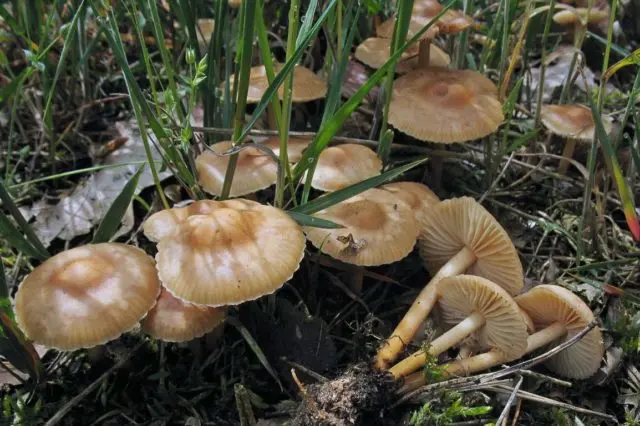
Collibia oil (chestnut) is more powerful than wood-loving, the leg is noticeably expanded downwards, the color of the top is brown, with white edges. It is also a conditionally edible mushroom with a cap diameter of up to 12 cm and a long (up to 13 cm) leg empty inside. The watery white flesh is tasteless and odorless. The hat looks oily only in wet weather, its color is brown-red, turning into light brown as the fungus grows.
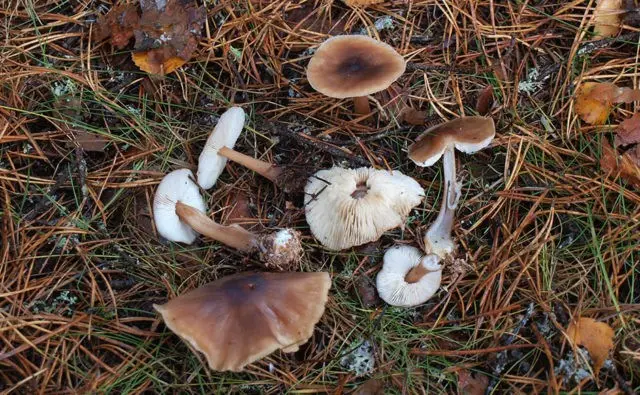
False mushrooms are poisonous, have a strongly convex hat of a yellow-cream color. When soaked, these mushrooms darken or even turn black.
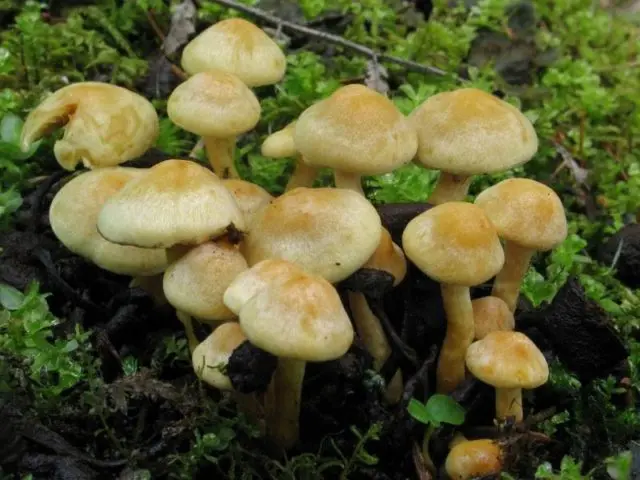
Inedible mushrooms have an unpleasant sour smell, reminiscent of spoiled cabbage. Their plates are yellow, darkening with time, sometimes completely black.
Poisonous mushrooms mainly grow in spring and autumn, they are rare in the summer months.
Conclusion
Collibia woody in the United States refers to poisonous mushrooms of low impact, because. can cause stomach cramps. In Our Country and in European countries, experienced mushroom pickers eat and harvest forest-loving (spring) mushrooms for the winter.









